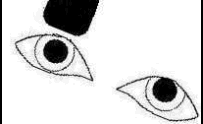This is a popular examination case. You will either
be asked to perform the three step tests or the ocular
motility examination. Remember that the patient may
have asymmetrical bilateral fourth nerve palsy.
On inspection, the patient may have an abnormal head posture
in the primary position with the head tilt ot the
unaffected side with chin depression. Alternatively,
the patient may be wearing glasses with prism.
In ocular motility examination.
There is overaction of the inferior oblique on
the affected side when the patient looks
to the unaffected side. On looking in and down, the affected
side has incomplete
depression (see picture above).
In the cover/uncover test
(Combine with the three-step tests see picture below.
The patient has a right fourth nerve palsy).

First step |

Second step |

Third step |
-
In the primary position, there is hyperdeviation of the affected
eye (first step).

Left fourth nerve palsy |
-
With the patient looking to either side, the test shows increased
deviation when the eyes look to
the unaffected side (second step).

Left fourth nerve palsy |
-
With the head tilt, the test shows increased deviation when
the head is tilted to the affected side
(third step).

Left fourth nerve palsy |
Additional features:
-
beware that the patient may have bilateral fourth nerve palsy
|





